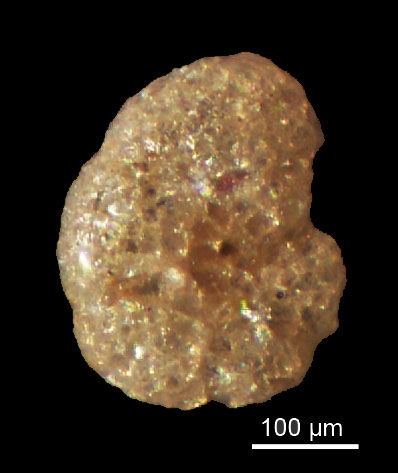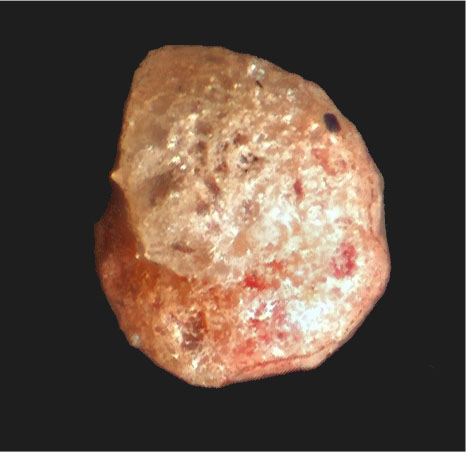Genus Haplophragmoides
Haplophragmoides Cushman, 1910
Type Description: Test free, planospiral, composed of several coils, each composed of a number of chambers, wall arenaceous, varying much in texture and in the relative amount of cement in the different species; aperture at the ventral border or on the lower portion of the apertural face of the chamber.
Haplophragmoides columbiense Cushman, 1925
Haplophragmoides columbiense Cushman, 1925, p. 39, p. 6, figs 2a 2b; Cushman and McCulloch, 1939: p. 72, pl. 5, figs. 8-10; McGann, 2007, p. 64, pl. 9, fig. H.
Alveolophragmium columbiensis (Cushman) Lankford and Phleger, 1973, p. 114, pl. 1, fig 8a, b.
Type description: Test somewhat compressed, close coiled becoming somewhat umbilicate in the adult, periphery rounded; chambers distinct, usually 6 or 7 in the adult, slightly inflated, sides flattened, increasing rather uniformly in size as added, generally triangular in side view; sutures distinct, somewhat depressed, usually sigmoid; wall composed of angular arenaceous fragments imbedded in finer-grained cement, smoothly finished, usually yellowish brown in color; aperture in adult elongate, transverse to axis of growth, in the median face of the chamber, with distinct lip-like process.
Remarks: Sen Gupta et al. (2009) synonymized Haplophragmoides columbiense with Labrospira columbiensis (Cushman, 1925) but only on a list of taxa, with no explanation. Loeblich and Tappan (1964) synonymized Labrospira Höglund (1947) with Cribrostomoides and designated a new lectotype for Cribrostomoides which differs from Haplophragmoides by the apertural features.
Distribution: The holotype of Haplpphragmoides columbiense is from Queen Charlotte Sound, British Columbia, from 46 m water depth. Cushman and McCulloch (1939) note that it is a common shallow-water species in Alaska and its range extends along the west coast to Port Utria, Columbia where is was collected at 90 m depth. H. columbiensis is not common in Puget Sound but is found in shallow water embayments.
Haplophragmoides planissima Cushman, 1927
Haplophragmoides planissima Cushman, 1927, p. 135, pl. 1, fig. 6; Cushman and Moyer, 1930, p. 51, pl. 7, fig. 3 ; Cushman and McCulloch, 1939, p. 78, pl. 6, fig. 3.
Ammotium planissimum (Cushman) Lankford and Phleger, 1973, p. 114, pl. 1, fig. 6.
Type description: Test large, slightly longer than broad, much compressed, involute, close coiled, slightly umbilicate, periphery acute; chambers and sutures indistinct; wall composed of a single layer of rather coarse angular sand grains with a large amount of grayish-white cement, exterior rough, wall fragile. Maximum length 1.50 mm, breadth 1.25 mm.
Remarks: Lankford and Phleger (1973) transferred this species to the genus Ammotiuim which has the distinguishing characteristic of “the later chambers tending to uncoil” (Loeblich and Tappan, 1964). Culver and Buzas (1985) used this designation in their catalogue of foraminiferal distribution along the northern Pacific. The specimens from Puget Sound do not uncoil in the later chambers and closely resemble those described and illustrated by Cushman (1927) and Cushman and McCulloch (1939).
Distribution: Similar to other Haplophragmoides species, H. planissima is most abundant in shallow water, partially enclosed waterways of Puget Sound.
Haplophragmiodes subglobosum (Cushman, 1927)
Lituola subglobosa Sars, 1869, p. 250.
Haplophragmoides subglobosum (Sars); Cushman, 1910, p. 105-106, figs. 162-164; Cushman, 1920, p. 45, pl. 8, fig. 5; Cushman and McCulloch, 1939, p. 80, pl. 6, figs. 7, 8. Todd and Low, 1967, pl. 1, fig. 7.
Labrospira subglobosa (Cushman, 1910) Vazquez Riviera and Patterson, 2008, fig. 5.4a
Specimens from Puget Sound all fall under the description of H. subglobosus being planispiral, not streptospiral, and each having a single interiomarginal aperture, not multiple nor interio-areal apertures, and without teeth.
Type description: Test usually planospiral consisting of two or more coils, involute, depressed at the umbilici, chambers very broad and low, wall arenaceous somewhat roughened but variable, chambers usually seven or eight in the last forming coil, making the test as a whole subglobose, aperture a more or less elongage slit at the base of the apertural face, simple; color gray or brown. Diameter 1-2.5 mm.
Remarks: Jones et al. (1993), in a study of the taxonomic history of H. subglobosum, the genus Cribrostomoides, and its type species C. bradyi Cushman, 1910, assigned precedence to the name Haplophragmoides subglobosus. These authors chose one of the original syntypic specimens as lectotype of H. subglobosus (United States National Museum of Natural History (USNM Registered Number USNM8219b) from Albatross Station D3603 in the North Pacific (3241m).
Specimens from Puget Sound all fall under the description of H. subglobosus being planispiral, not streptospiral, and each having a single interiomarginal aperture, not multiple nor interio-areal apertures, and without teeth.
Distribution: This species is found scattered throughout the Sound and in common in the South Sound embayments and at the distal end of Hood Canal.





